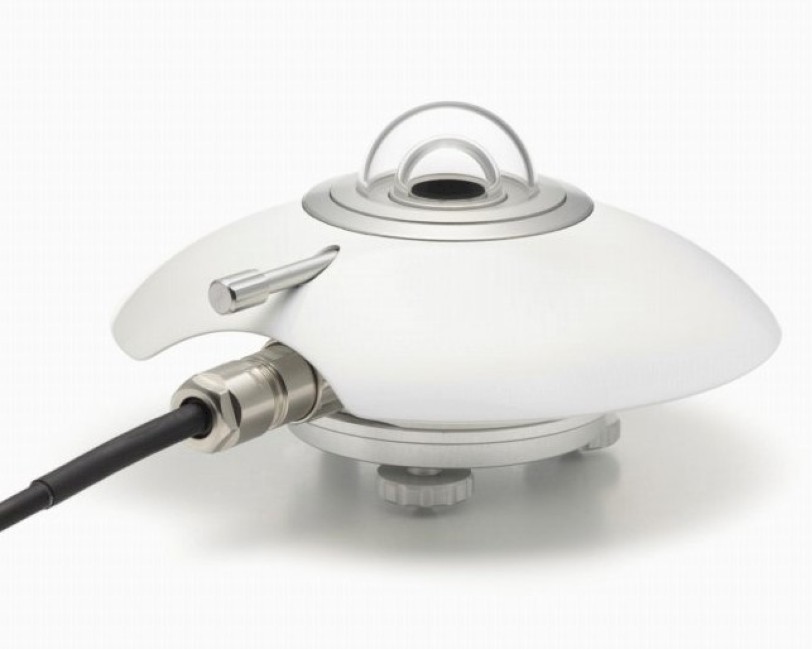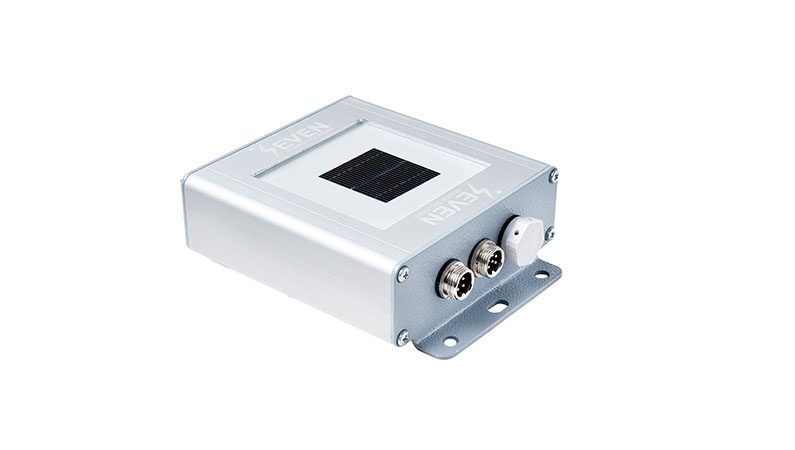The Reference Cell Solar Irradiance Sensor is the best solution for monitoring PV Solar Plants as it is a miniature of PV Panels.
Comparison of Pyranometers Vs. Reference Cell Solar Irradiance Sensors
The two most popular tools used by the photovoltaics (PV) industry for measuring irradiance are thermopile pyranometers and calibrated Reference Cell Solar Irradiance Sensors. Currently, the PV community has a poor understanding of which device is better suited for PV applications.
Pyranometers
Thermopile pyranometers (which we refer to in this work simply as “pyranometers”) are devices that have junctions of dissimilar metals in contact with a painted black surface that absorbs solar radiation (the “hot” junction) and a separate surface that does not absorb solar radiation (the “cold” junction). They measure irradiance indirectly by measuring the temperature difference between these two surfaces.

Pyranometers have an essentially flat spectral response from ~400 to ~2700 nm, the transmittance of quartz. Because of this flat spectral response over a wide range of incident wavelengths, pyranometers are well suited to measure total incident shortwave radiation, independent of the spectral composition of that radiation. Pyranometer uncertainties are usually quoted with respect to the measurement of total incident solar radiation.
Reference Cell Solar Irradiance Sensors
Reference Cell Solar Irradiance Sensor is a miniature of a PV Panel. It converts incident photons to electrons through the photovoltaic effect, and then these electrons generate a measurable electric current, same as PV Panels. The efficiency of this photon-to-electron conversion is a wavelength-dependent function that is specific to various PV device technologies, and to some extent, to individual PV devices.

the current of the reference cell is measured by measuring the voltage across a small resistor that is included in the reference cell package. This voltage is calibrated under the reference spectrum [ASTM G173, or IEC 60904-3 spectrum] at 1000W/m2, 25 °C using standard techniques [IEC 60904-1].
When is the Reference Cell Solar Irradiance Sensor More Advantageous?
Reference Cell Solar Irradiance Sensors offer an economical but robust and reliable solution for measuring solar irradiance levels, particularly for monitoring photovoltaic systems.
The design of these solar irradiance sensors, which corresponds to that of a photovoltaic module, make these sensors ideally suited as a reference for monitoring photovoltaic systems.
The spectral sensitivity, which corresponds to that of photovoltaic modules, and the very similar incident angle modifier, enable a precise analysis of photovoltaic yields using measured values from the sensor.
Enables precise measurement of PV performance to detect degradation or deviation from expected performance.
Even in the case when the goal of the user is to measure broadband irradiance, a Reference Cell Solar Irradiance Sensor may exhibit the same or better (under other conditions) measurement uncertainties than thermopile pyranometers.
Comparison Chart of Pyranometer Vs. Reference Cell Solar Irradiance Sensor features
| Reference Cell Solar Irradiance Sensor | Thermopile Pyranometer | |
|---|---|---|
| Spectral Response | Reference Cell Solar Irradiance Sensor measures only the spectral part the solar cell can convert to electricity. | Pyranometer measures the whole spectral range of the sun. |
| The cost | Economical but robust and reliable solution for measuring solar irradiance levels | Expensive solution for PV monitoring system. |
| International standards for calibration | -All Standards IEC 904; -There is a special standard (IEC 61724-1) for controlling and monitoring the PV system. |
The Standard ISO 9060. |
| PV system control | The Reference Cell Solar Irradiance Sensor is a good choice for controlling the PV system because they have nearly the same physical behavior as the PV Modules. | A totally different physical behavior with the PV system which can be problematic for measuring and controlling PV performance. |
| Response Time | Milliseconds, it matches with PV response. | Slow, it’s up to 30 seconds. |
| Temperature response | Similar to PV system, Linear temperature response allows for corrections. | Designed to minimize sensitivity to temperature. Not corrected for temperature effect. |
| Incident Angle Modifier | The reflection of the sun at the flat glass of the Reference Cell Solar Irradiance Sensor is much higher. | The reflection of the sun at the glass dome of the pyranometer is lesser than the reflection at the Reference Cell Solar Irradiance Sensor. |
| Application | For the characterization of the PV performance, the Reference Cell Solar Irradiance Sensor allows better detection of changes in PV system. | For measuring the global horizontal irradiance, the pyranometer is recommended to be used. |
| Connection | Reference Cell Solar Irradiance Sensor has 3 inputs ensuring the connection of Module Temperature Sensor, Ambient Temperature Sensor and Wind speed sensor with only one Modbus RTU output connected directly to the datalogger. | The pyranometer can only be connected to the datalogger without combining any other sensor Data. |
Conclusion
the Reference Cell Solar Irradiance Sensors are especially useful for precise characterization of the PV performance, allowing better detection of changes in PV system performance with shorter time assessment of the PV operating efficiency. Even in the case when the goal of the user is to measure broadband irradiance, a Reference Cell Solar Irradiance Sensor may exhibit the same or better measurement uncertainties than thermopile pyranometers.
When utilizing the thermopile pyranometers for measuring useable incident energy for a PV power plant, uncertainty is introduced when the spectrum changes because the pyranometer and PV plant respond differently to different spectra. Well, the pyranometers may still be useful for comparing observed broadband irradiance to historic broadband irradiance.
According to the comparison we made between the Reference Cell Solar Irradiance Sensor and the thermopile pyranometers; we conclude that Reference Cell Solar Irradiance Sensor provides superior irradiance measurements for PV power plant monitoring applications.